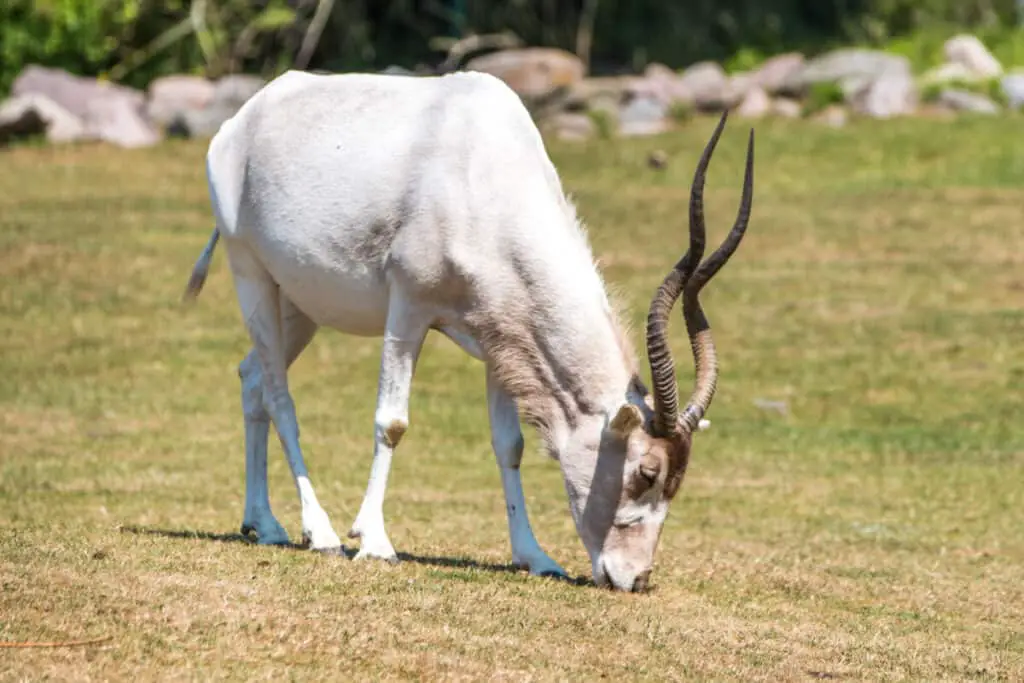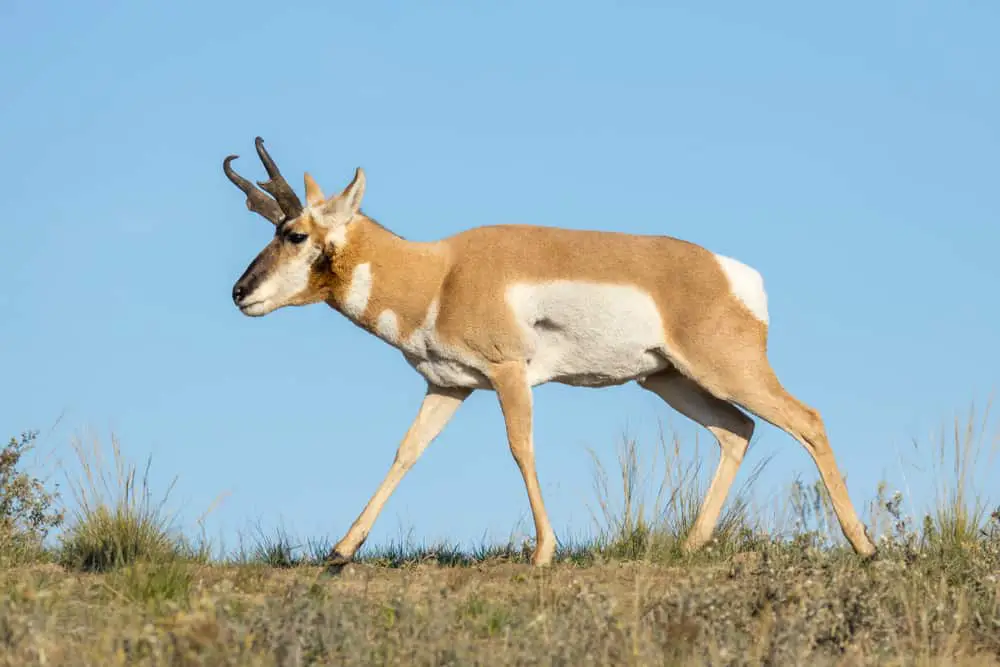Antelope are a diverse group of hoofed mammals that inhabit various regions across the world. These animals have highly adapted to their specific geographic habitats, and some species have become so specialized they can only survive in very particular ecological niches.
This article will provide an overview of antelopes, including physical characteristics, behavior and ecology, as well as conservation threats facing these creatures.
The family Bovidae consists of over 140 antelope species which are divided into two subfamilies: Caprinae (goats and sheep) and Antilopinae (antelopes). The latter includes gazelles, impalas, duikers, blesboks and other small to medium-sized ungulates with horns or antlers.
Morphologically speaking, most antelopes share common features such as long legs for running quickly, cloven hooves for gripping slippery surfaces, coats of fur for camouflage and protection from predators, scent glands for marking territories and attracting mates during the breeding season.

Overview Of Antelope Species
Antelopes are an iconic species of ungulate mammals native to Africa and parts of Asia. They are often characterized by their varied body sizes, ranging from small duikers to large gazelles and antelope-like animals such as the kudu. Their habitats range from open plains and savannahs to light woodlands or even deserts, depending on the species.
The lifestyles of antelopes vary according to their particular species, but many have a tendency for territorial behavior among males during mating season. Furthermore, some may form breeding herds or migrate in response to seasonal changes in food availability or weather conditions.
Male antelope will typically engage in complex mating rituals that involve displaying physical strength or other behaviors meant to attract potential mates. Additionally, certain kinds of antelope may travel long distances between summer and winter ranges due to migratory patterns determined by environmental factors like temperature or rainfall levels.
In sum, the lifestyle of any given antelope is largely influenced by its environment and the specific traits of its species.
| Species | Location |
|---|---|
| Impala | Southern and Eastern Africa |
| Springbok | Southern Africa |
| Sable Antelope | Eastern and Southern Africa |
| Oryx | Sahara Desert and arid regions |
| Wildebeest | Eastern and Southern Africa |
| Gemsbok | Southern Africa and Namibia |
| Eland | Sub-Saharan Africa |
| Thomson’s Gazelle | East Africa (Kenya and Tanzania) |
| Roan Antelope | Sub-Saharan Africa |
| Addax | Sahara Desert and arid regions |
Please note that this table includes only a selection of antelope species and their general locations. There are numerous other antelope species with different ranges across Africa and other parts of the world.
Physical Characteristics
The antelope is a fascinating animal, with elegant physical and behavioral traits that have captivated humans for centuries. Going beyond the surface level of their beauty and grace, an exploration of the antelope’s physical characteristics reveals complex adaptations to diverse habitats across Africa and Asia.
Mating rituals among antelopes vary wildly depending on species; some exhibit monogamous behavior while others are polygamous or practice same-sex pairings. In addition to mating behaviors, size varies greatly as well – from small duikers weighing in at only twenty pounds up to giant elands exceeding one thousand pounds! Social structure also differs according to species ranging from solitary living to large herds numbering in the hundreds.
Interestingly, these structures can change rapidly due to seasonal migration patterns driven by food availability and other factors. Overall, antelopes demonstrate remarkable versatility and resiliency when it comes to their environment.
No matter what kind of terrain they inhabit or how they express themselves romantically, each species has developed sophisticated strategies for survival over millennia which allow them to thrive in even the harshest conditions. This remarkable adaptability ensures that antelopes remain an integral part of many African and Asian ecosystems today.
Pronghorns’ Predators Revealed: Unmasking the Threats
Behavior And Ecology
Antelope are found around the world in a variety of habitats, including grasslands, savannas, and deserts. They typically form herds that move between seasonal ranges with males competing for mating rights during the breeding season. Mating rituals vary among species but generally involve several individuals vying to be chosen by a single female. Males may engage in physical combat or ritualized displays of strength and size to gain dominance over other suitors.
Habitat selection is an important part of antelope survival and reproduction as it determines access to food resources and protection from predators. For example, springbok tend to prefer short-grass plains while impala favor tall grasses near water sources such as rivers and streams. The habitat must also provide ample cover for them to hide from potential danger since their speed makes flight rather than fight their primary defense mechanism. It is essential for these animals to have enough space within any given area so they can disperse quickly if need be.
The habitat requirements of antelopes must be met in order for populations to remain healthy and viable over time. As they compete with humans for available land it is becoming increasingly difficult for them to find suitable areas where they can survive without interference or persecution.
Conservation efforts are needed worldwide in order to ensure adequate protection of both current and future habitats used by this diverse group of mammals.
Impalas and Their Predators: Unmasking the Threats
Feeding Habits
Antelope are known for their dietary diversity, feeding on a wide range of plant and animal matter. They consume both grasses and herbs as well as bark, leaves, buds, and fruits from trees; some species even eat insects such as locusts.
Their nutritional requirements vary according to the season: during winter months they feed mainly on dry vegetation such as hay or straw, while in spring-summer they switch to fresh shoots and foliage.
The antelope’s diet is reflected in its body structure which includes highly developed digestive organs – four chambers in the stomach that allow it to break down all types of nutrients found in its food sources. This versatility allows them to survive under different climatic conditions and inhabit a variety of habitats including savanna grasslands, wooded areas, deserts, mountains, and wetlands.
Some key points about the antelope’s feeding habits include:
- Dietary diversity with an ability to consume a wide range of plants & animals
- Nutritional needs vary depending on the season
- Body structure adapted to breaking down all kinds of nutrients available
Family Antilocapridae: Unraveling the Pronghorn Antelope
Conservation Threats
The antelope is a species that faces numerous conservation threats, both from human activity and the natural environment. Metaphorically speaking, these threats create an obstacle course for their survival; one with no clear path to success or victory. In order to identify actions which can be taken in order to ensure the continued existence of this majestic creature we must first understand what threatens them the most.
Habitat destruction has been identified as one of the leading causes of population decline among many different species including antelopes. This threat encompasses any activities such as deforestation, urbanization, pollution, poaching and overgrazing which lead to the loss of essential food and shelter resources necessary for antelopes’ survival.
Additionally, climate change is another major factor causing environmental instability resulting in extreme weather conditions and habitats becoming unsuitable for sustaining life. These two threats combined have had a devastating effect on populations around the world, making it increasingly difficult for antelope species to survive into future generations without direct help from humans.
Therefore, it is important that we take responsibility and implement various strategies in order to protect both existing habitat areas and restore those already damaged by human activities. It will also require international collaboration towards mitigating climate change effects through emissions reductions and other measures such as reforestation efforts that would increase carbon capture rates worldwide. With sufficient effort, dedication and commitment from all parties involved we can ensure that our planet continues hosting enough wild places where antelopes may thrive freely in harmony with nature once again.
Unique Adaptations
Antelopes have unique adaptations that allow them to survive in their natural habitats.
Migration patterns are important for antelopes, as they enable them to find food and water sources when resources are scarce. During the dry season, many species of antelope migrate over long distances in order to access more nutritious vegetation and reliable water sources. They also use migration patterns to avoid predation; by migrating away from areas with high levels of predators, antelopes can reduce their risk of being killed or injured.
Predation strategies are also an essential adaptation for antelopes. Many species employ a mixed strategy involving both flight and fight responses, so that they can choose between running away or standing their ground depending on the situation. Some species will even work together in groups to protect one another against predators such as lions and cheetahs. In addition, some antelope species have evolved physical characteristics like horns which help them defend themselves against predators.
By taking advantage of these various adaptations, antelope species have been able to successfully inhabit different ecosystems around the world and thrive despite competition from other animals and threats posed by humans.

Conclusion
Antelopes are unique and fascinating animals. They have evolved with physical characteristics, behaviors, and feeding habits that make them well-suited to the environment in which they live.
While their conservation status is threatened due to habitat destruction and poaching, many species of antelope still remain today.
Adaptations such as powerful legs for running long distances enable antelopes to evade predators in the wild. This adaptive behavior has been compared to an Olympic sprinter; when faced with a predator, some species of antelope can attain speeds up to 77 km/h – similar to Usain Bolt’s world record speed of 44 mph (71 km/h).
Antelopes’ ability to survive despite facing adversity demonstrates their resilience and adaptability, making them truly remarkable creatures.
